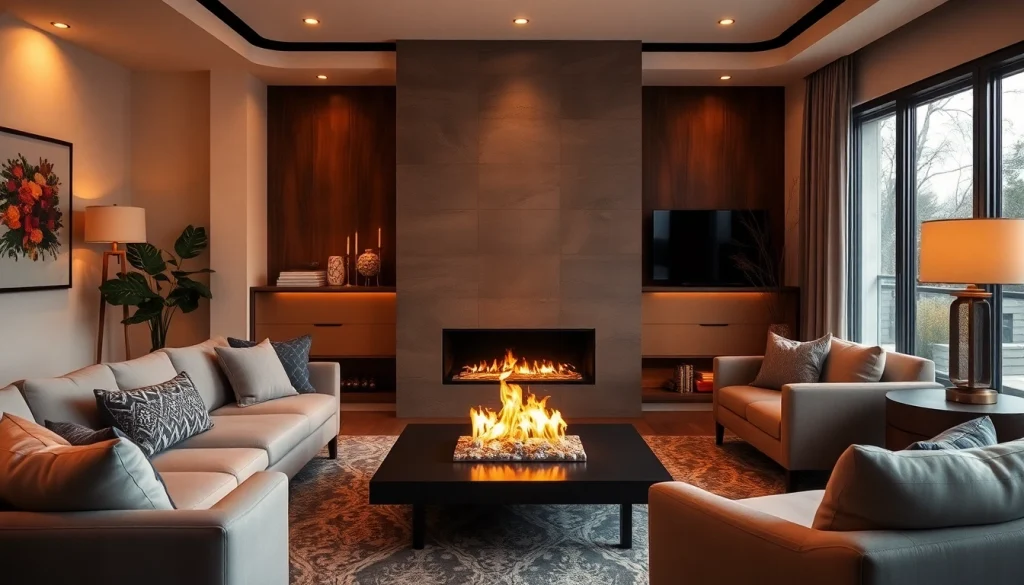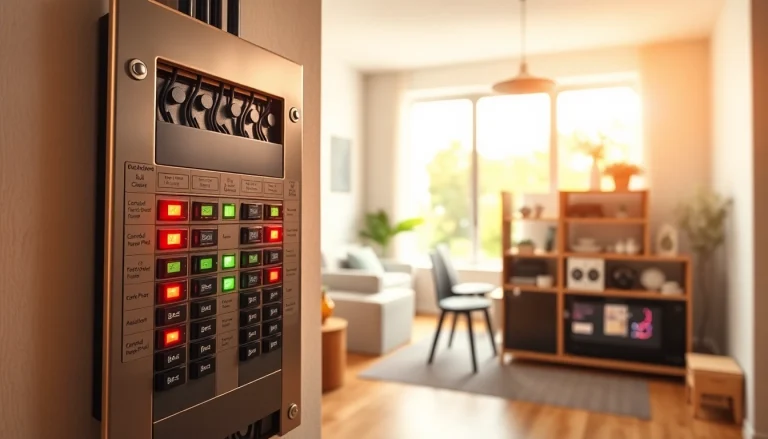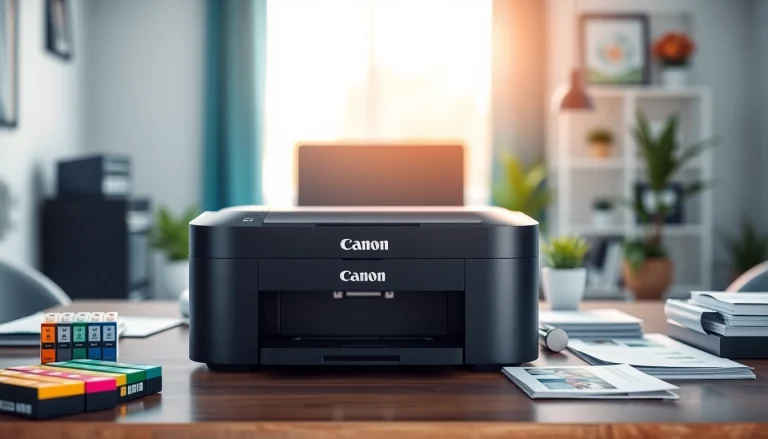
Understanding Water Vapor Fireplaces
What is a Water Vapor Fireplace?
A water vapor fireplace is an innovative heating solution that utilizes advanced technology to simulate real flames while eliminating the dangers associated with traditional fireplaces. Instead of using wood or gas, these electric appliances create a stunning flame effect using water vapor combined with LED lights, producing a three-dimensional illusion of flickering flames. Not only does it provide the warm ambiance of a classic fireplace, but it also operates without the hazards of open flames or harmful emissions, making it an excellent alternative for modern homes.
How Do Water Vapor Fireplaces Work?
The operation of a water vapor fireplace relies on ultrasonic technology. When the unit is activated, it vibrates at a high frequency, creating tiny droplets of water that are expelled into the air, forming a fine mist. Water vapor fireplace models combine this mist with LED lights. As the light shines through the vapor, it reflects off the droplets, creating a mesmerizing illusion of flames dancing and flickering just like a real fire. This unique mechanism provides all the aesthetics of a traditional fireplace while ensuring a safe, cool-to-the-touch surface and a clean environment.
Benefits of Choosing Water Vapor Fireplaces
Choosing a water vapor fireplace comes with numerous advantages:
- Safety: With no flames and cool surfaces, water vapor fireplaces are safe for homes with children and pets.
- Low Maintenance: Unlike wood-burning units that require extensive cleaning and ash disposal, these fireplaces need minimal upkeep, primarily water refills and occasional cleaning of the mist system.
- Energy Efficiency: Water vapor fireplaces typically consume less energy than traditional gas or electric fireplaces, making them a cost-effective option.
- Environmentally Friendly: They emit no harmful emissions, maintaining indoor air quality for families.
Safety Features of Water Vapor Fireplaces
Flame-Free Ambiance
One of the most significant safety features of water vapor fireplaces is the absence of real flames. This creates a stress-free environment since there is no risk of accidental fires. The flame-free ambiance offers peace of mind, especially for those living in homes with small children or pets. Additionally, since these units do not produce actual heat, they remain cool to touch, eliminating the risk of burns that traditional fireplaces pose.
Child and Pet Safety Considerations
Water vapor fireplaces have been designed with families in mind. The lack of hot surfaces or open flames means children can enjoy the visual effect of the fire without danger. Moreover, for pet owners, the absence of fire hazards reduces the risk of accidents or injuries, allowing pets to roam freely without anxiety.
Environmental Benefits
In an age of increasing environmental awareness, water vapor fireplaces stand out as a green choice. They do not release smoke or harmful byproducts into the environment. This feature appeals to eco-conscious homeowners looking to reduce their carbon footprint. Additionally, since the units utilize water, they can also contribute to atmospheric humidity, which can benefit indoor plants and enhance comfort in dry climates.
Installation and Maintenance
Installation Process Overview
Installing a water vapor fireplace can vary depending on the model—wall-mounted, free-standing, or inserts. Generally, the process includes:
- Choosing the Location: Select a spot in your home that benefits from the aesthetic appeal and aligns with your power outlets since water vapor fireplaces require an electrical source.
- Preparing the Area: Make sure the wall is suitable if it’s a mounted model, and check for any obstructions.
- Electrical Connection: Most units will need a basic electrical connection, so ensure you have the necessary outlets nearby or plan for professional installation.
- Setting Up the Fireplace: Follow the manufacturer’s instructions for securing the unit and filling the water reservoir.
- Testing the Unit: Once installed, fill the reservoir with water and turn on the fireplace to familiarize yourself with its operation.
Routine Maintenance Tips
While water vapor fireplaces are low maintenance, there are some essential tasks to ensure they operate effectively:
- Regular Water Refills: Check and refill the water reservoir regularly; most models require maintenance every few days, depending on usage.
- Cleaning the Mist System: Every few weeks, clean the ultrasonic transducer and any other parts that might accumulate scale from minerals in the water. It can prolong the life of the unit.
- Inspecting Connections: Periodically check electrical connections for any wear or damage and ensure that the unit is securely mounted.
Common Mistakes to Avoid
To ensure a long-lasting and efficient water vapor fireplace experience, avoid the following common pitfalls:
- Using Tap Water: Always use distilled or filtered water to prevent mineral buildup that can affect performance.
- Neglecting Maintenance: Regular maintenance is key to preventing issues; don’t skip on cleaning and checking the unit.
- Improper Setup: Follow installation guidelines precisely to avoid operational issues or damage to the unit.
Comparing Water Vapor Fireplaces to Traditional Models
Energy Efficiency and Cost
When it comes to energy efficiency, water vapor fireplaces outperform traditional models. They consume significantly less energy, which translates into lower operating costs. Traditional wood-burning and gas fireplaces typically require more energy to heat the home and consume resources, while water vapor models primarily use electricity and rely on ambient heat, saving homeowners money in the long run.
Aesthetic Differences
Water vapor fireplaces excel in delivering a mesmerizing visual effect that rivals the aesthetic appeal of traditional flames. While wood-burning fireplaces produce real flames and crackling sounds, water vapor models offer a modern, sleek design and are customizable with different colors and styles. The mist effect can create a visual illusion of flames dancing in a way that adds a contemporary twist to any setting, making it an attractive option for modern interiors.
Long-Term Value Comparison
In terms of long-term value, water vapor fireplaces can be considered a worthwhile investment. They come with lower maintenance costs and energy consumption, whereas traditional fireplaces may require expensive repairs over time due to corrosion from wood smoke or complications in gas systems. Water vapor models also boast longevity since they do not rely on combative combustion processes, ensuring they can serve homeowners reliably for many years if maintained correctly.
Choosing the Right Water Vapor Fireplace for Your Home
Key Features to Consider
When selecting a water vapor fireplace, consider these key features:
- Size and Style: Choose a unit that fits your space and matches your interior design.
- Heating Capability: Determine if you need a model with heating options or if you prefer an ambiance-only setup.
- Water Capacity: Larger reservoirs mean longer operational times before refilling.
- Customization Options: Look for models that allow you to customize flame colors or intensity.
Popular Brands and Models
Several brands are well-known for their high-quality water vapor fireplaces, including:
- Aquafire: Known for advanced technology and high-quality units that provide a realistic flame effect.
- Dimplex: Offers a variety of designs, including efficient models that fit seamlessly into any setting.
- Modern Blaze: Features a range of stylish, customizable options that enhance home aesthetics.
Price Range and Options
The price of water vapor fireplaces can vary widely based on factors such as size, features, and brand. Basic models may start around $300, while more elaborate units with heating capabilities and larger water tanks can reach $1,500 or more. Consider what fits your budget and needs. Investing in a quality unit may pay off in energy savings and enjoyment over the years.






